With the continuous expansion of the power grid, the traditional construction models of centralized power generation and long-distance transmission have shown more and more limitations. On the other hand, with the continuous depletion of conventional fossil fuels, clean and efficient renewable energy generation technologies have received widespread attention. In order to address the challenges, many countries have proposed a future power grid development strategy centered on the construction of smart grids. Microgrids can integrate a large amount of distributed energy generation, which helps solve various problems encountered by large grids and is an important component of the distribution network in future smart grids.
User side photovoltaic microgrid is an organic whole composed of photovoltaic power generation units, energy storage equipment, and user groups. It is connected to the external power grid through public connection points to achieve interactive management of power generation, storage, and consumption equipment in this area. It is generally distributed in large residential communities or large industrial and mining enterprises and directly connected to the 380V user side distribution network.
In recent years, various countries have actively formulated photovoltaic power generation subsidy policies, proposed a photovoltaic power generation parity grid system, and rapidly developed smart grids and building photovoltaic industries, further providing opportunities for the rapid development of user side photovoltaic microgrids. At present, demonstration projects for user side photovoltaic microgrids in China include the 120 kW user side photovoltaic microgrid system at Hangzhou University of Electronic Science and Technology and the 250 kW user side photovoltaic microgrid system at CRRC Corporation. The photovoltaic installed capacity of the Hangzhou University of Electronic Science and Technology project accounts for 50% of the total primary energy capacity of the microgrid system, while the photovoltaic installed capacity of the China CSR Group project accounts for 70% of the total primary energy capacity of the microgrid system.
The operation control of microgrids is the most important topic in the field of microgrid research [8]. In addition, microgrid planning, design, optimization of operation, power flow calculation, stability and reliability, and relay protection are all current research hotspots in the field of microgrids. A large amount of literature has conducted in-depth research on this, but the above-mentioned research hotspots have not paid enough attention to user needs. With the large-scale integration of distributed photovoltaic power generation systems on the user side, the possibility of forming typical user side microgrids based on households, buildings, and communities has greatly increased. Therefore, further improvement is needed in terms of user side microgrid topology, distributed power supply access methods, and other aspects.
We will focus on researching user side microgrids that are only connected to photovoltaic power generation and energy storage systems. We will study the characteristics of commercial user side microgrids and the ways in which distributed power sources are connected to user side microgrids. We will design and analyze the typical topology of user side microgrids, which is the basis for achieving coordinated control of power generation, storage, and consumption equipment in the user side microgrid area, optimizing energy efficiency management, and ensuring safe and reliable electricity consumption by users.
1. Characteristics of commercial user side microgrids
According to the Technical Guidelines for Urban Distribution Networks of China Southern Power Grid, the electrical loads in low-voltage distribution networks can be divided into residential, commercial, and office types. Due to the similarity in estimated values between commercial and office loads, commercial and office loads are simplified as office loads. Therefore, the electricity load in low-voltage distribution networks can be divided into commercial residential and commercial office types. The microgrid established based on this load center is called the commercial residential user side microgrid and the commercial office user side microgrid.
Except for high-end residential buildings and villas with a load density of 12-20 kW/set, the load density of other residential types is below 10 kW/set. Therefore, the microgrid on the user side of commercial residential types is mostly aimed at users with electricity consumption power below 10 kW. The commercial residential user side microgrid adopts 220V single-phase power supply, and the DC-AC inverter and AC-DC rectifier are all single-phase equipment, mostly using independent household distribution boxes. However, the independence between residential users also poses significant difficulties for the large-scale development of user side microgrids.
The load density of commercial office type is about 80-120 kW/m2, so the microgrid on the user side of commercial office type is mostly aimed at users with a power consumption of 10-150 kW. The commercial office user side microgrid adopts 380 V three-phase power supply, and the DC-AC inverter and AC-DC rectifier are all three-phase equipment, mostly using floor distribution boxes or household distribution boxes. The distribution types of commercial office microgrid users can be further subdivided into three types based on the nature of the owners, that is, the same building belongs to the same owner; The same floor belongs to the same owner; The same floor belongs to different owners in different areas.
Due to the similarity between the first and second types, as the related loads belong to the same owner for the same building or floor, the first and second types can be merged into one.
Based on the actual situation (load situation, number of new energy sources that can be connected, etc.), only the latter two situations will be studied here.
2. The way for distributed power sources to connect to commercial user side microgrids
User side microgrids can be divided into commercial residential microgrids and commercial office microgrids based on load conditions. This section will analyze the ways in which distributed power sources connect to commercial residential microgrids and commercial office microgrids from the perspective of user side microgrid classification, combined with the characteristics of distributed power sources themselves.
2.1 Ways for Distributed Power Sources to Connect to Commercial Residential Microgrids
There are four main ways for distributed power sources to connect to commercial residential microgrids. The details are as follows.
(1) Priority power supply for photovoltaic systems, supplemented by mains electricity
As shown in Figure 1, this scheme mainly refers to the power supply scheme of “UPS”. By replacing the UPS with a photovoltaic system, this method of power supply can be achieved. The principle is to control the DC-DC open circuit output voltage at the output end of the photovoltaic system to be higher than the output voltage of the incoming power bus after passing through AC-DC. When the photovoltaic is sufficient, due to the voltage difference, it ensures that the photovoltaic supplies power to the load; When the photovoltaic power is insufficient, the voltage of DC-DC decreases, and at this time, the incoming power bus passes through AC-DC to provide power to the load.
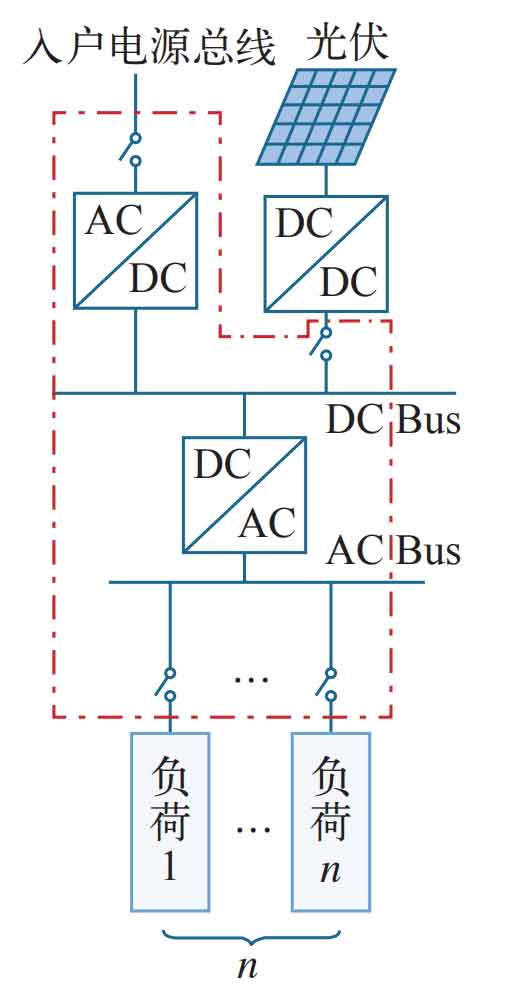
This method is more convenient and does not require scheduling to achieve the utilization of photovoltaic power generation. However, as shown in the red box in Figure 1, it is necessary to renovate the household distribution box, which is quite cumbersome and requires additional DC-DC controllers for the photovoltaic system and AC-DC controllers for the power bus.
(2) Direct integration of photovoltaic systems into household distribution boxes
As shown in Figure 2, this scheme can directly add a switch in the household distribution box to connect the photovoltaic system, making the wiring modification of the system very convenient. If users are allowed to reverse power transmission to the grid, the photovoltaic system can adopt the maximum power tracking control method, which is not complicated, but the bidirectional metering algorithm will become more complex; If users are not allowed to reverse power transmission to the grid, the photovoltaic system needs to adjust power control according to the load situation, and the control algorithm of the inverter will become more complex.
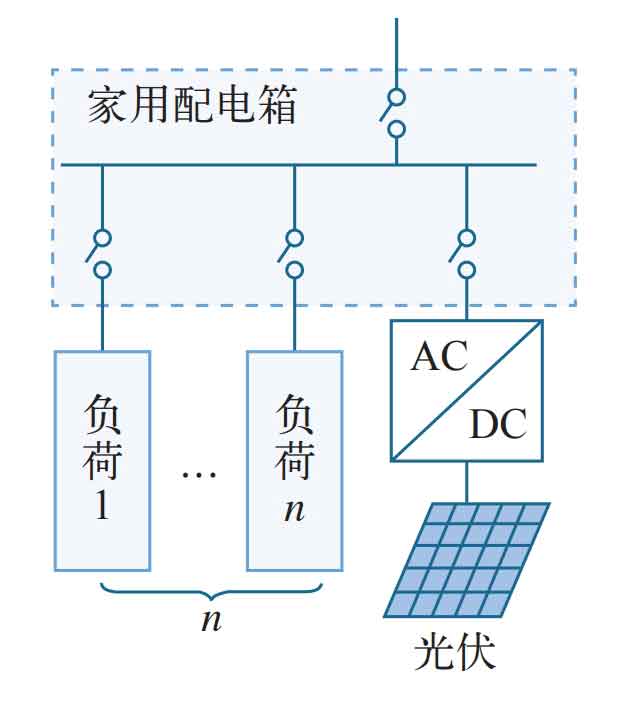
This method can facilitate the transformation of distribution lines, but the control algorithm will become more complex.
(3) Both photovoltaic and energy storage systems are directly integrated into household distribution boxes
As shown in Figure 3, this scheme can directly add a switch in the household distribution box to connect the photovoltaic system and energy storage system, and the wiring modification of the system is very convenient. This topology can achieve off grid or grid connected power supply for household users. When connected to the grid, it is possible to achieve reverse power transmission without going to the grid; When running off the grid, it is possible to maintain normal power supply for household loads for a certain period of time.
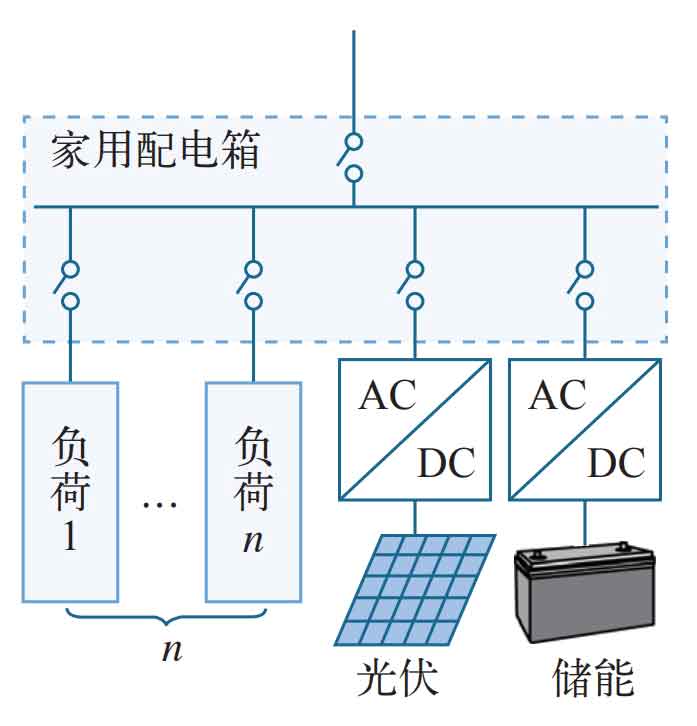
This method can easily achieve the transformation of distribution lines, but the control algorithm will become more complex, and the cost of line transformation and primary equipment will correspondingly increase.
(4) Direct integration of energy storage systems into household distribution boxes
As shown in Figure 4, this scheme can directly add a switch in the household distribution box to connect the energy storage system, and the wiring modification of the system is very convenient. This topology can achieve off grid or grid connected power supply for household users. When connected to the grid, the energy storage system can be controlled for charging; When running off the grid, it is possible to maintain normal power supply for household loads for a certain period of time.
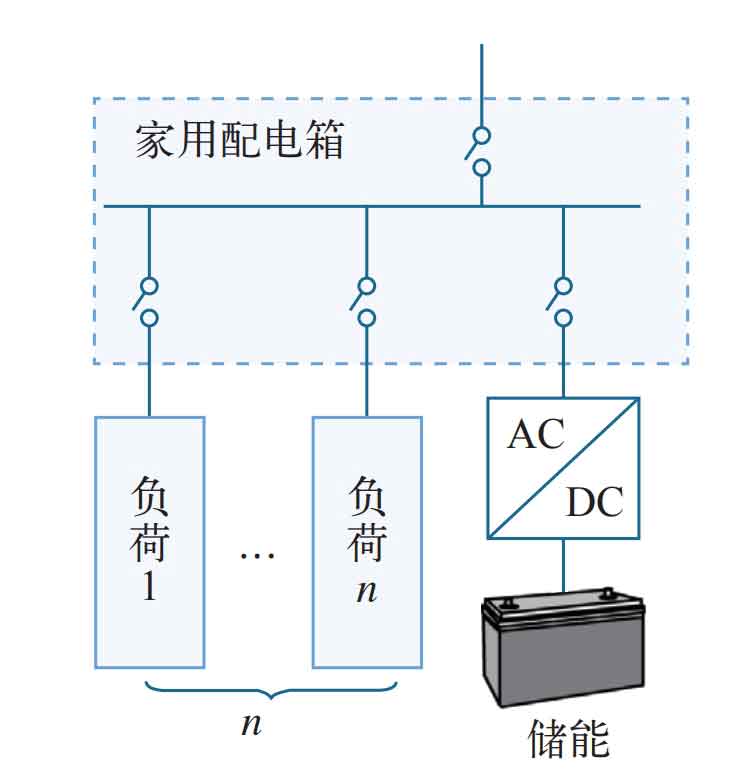
This method can easily achieve the transformation of distribution lines, and the control algorithm of the system is also relatively simple, but the unit cost of the system is relatively high.
The above four distributed power supply access methods are all aimed at single-phase systems. In order to ensure that the equivalent load of the entire floor is as symmetrical as possible, it is recommended to merge the same type of three household systems into different phase lines. Each phase line has four different types of user topologies.
2.2 How to connect distributed power sources to commercial office microgrids
The distribution types of commercial office type microgrid users can be divided by the nature of the owners into the same floor belonging to the same owner and the same floor belonging to different areas belonging to different owners. Next, we will analyze the connection methods of distributed power sources from two different distribution types.
(1) Under this method, the same floor belongs to the same owner. Due to the clear allocation of loads in each floor, and considering the demonstration requirements and convenient wiring, the connection of micro power can be achieved through a centralized connection to the floor distribution box. The specific user type topology is shown in Figure 5.
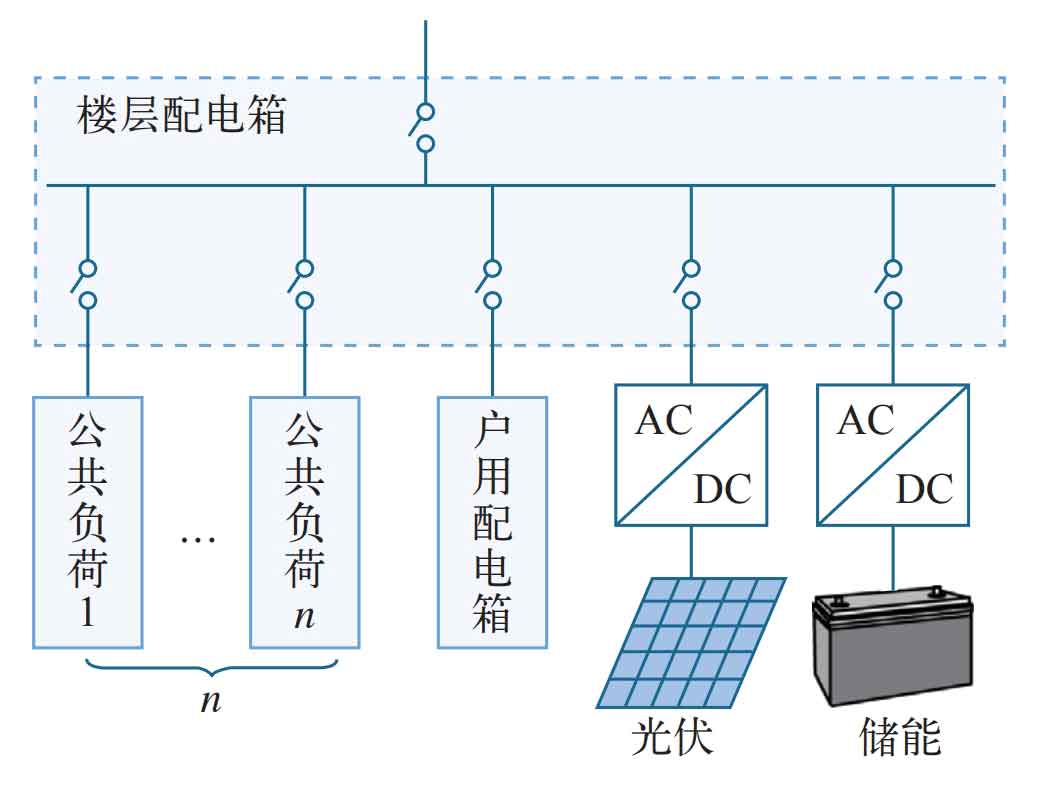
For this type of microgrid, since the loads on each floor belong to the same owner, centralized access can be used for micropower supply. This design has the following advantages: unified access, simple wiring method; Centralized access points can avoid line renovation; There are few control points for centralized access, and the control is simple. The only drawback is that if the micro power supply fails, the system will not be able to achieve off grid operation.
1) When the microgrid is integrated into the main grid for operation, the micropower source can be controlled to meet the needs to the maximum extent according to the load demand. When the load is high and the power of the micro power supply cannot meet the requirements, electrical energy can be obtained from the power grid; When the load is low, control the photovoltaic and energy storage systems to not send electricity back to the grid.
2) When the microgrid operates in isolation, the battery serves as the main power source to detect the power of the load, control the photovoltaic and energy storage systems, and ensure that the system can stably supply power to the load.
(2) The same floor is divided into different areas and belongs to different owners. Similar to the analysis in section 2.1, there are also four different ways for distributed power sources to connect to commercial office microgrids, namely “priority power supply for photovoltaic systems, supplementary power supply for urban electricity”, “direct integration of photovoltaic systems into user distribution boxes”, “direct integration of photovoltaic systems and energy storage systems into household distribution boxes”, and “parallel integration of energy storage systems into household distribution boxes”. The advantages and disadvantages of these four methods are the same as those in section 2.1, but the difference from the above four methods is that the AC-DC converter and DC-AC converter in the system are all three-phase.
3. Primary topology design and analysis of commercial user side microgrids
The access methods of distributed power sources vary depending on the type of microgrid on the user side, resulting in differences in their grid connected and off grid operation performance. This section will comprehensively design the overall topology of commercial user side microgrids based on the characteristics of commercial user side microgrids and the access methods of distributed power sources.
3.1 Primary topology of commercial and residential microgrids
As shown in Figure 6, the topology of the microgrid on the user side of commercial residential buildings mainly focuses on ordinary residents. The electricity voltage for ordinary residents is generally 220 V, and there is a distribution box for every household. The distribution box collects all the loads and other power sources (including energy storage and photovoltaics) of the residents. Considering the issue of ownership of household equipment, the commonly used topologies for residents in their homes mainly include the following types: in addition to common loads, there is also a photovoltaic system (divided into the first type and the second type according to function, as shown in Figure 6); In addition to common loads, there are also photovoltaic systems and energy storage systems; In addition to common loads, there is also an energy storage system. Considering the large capacity configuration of distributed photovoltaics and the fact that only 1-2 households need to be equipped with photovoltaic panels or battery packs for each type, there is still a certain number of photovoltaic panels that can be connected to the floor. Due to the fact that the entire user side microgrid still needs to have certain off grid operation functions, it is necessary to configure a certain capacity of batteries in the main distribution network.

1) When the microgrid is integrated into the main grid for operation, the newly added public loads (such as high-power water heaters) are not put into use, and each type of user is controlled to ensure that the new energy can meet their needs to the greatest extent possible. When the load is high, electricity can be obtained from the grid or floor centralized photovoltaic and energy storage systems; When the load is low, control the shared photovoltaic and energy storage systems on the floors to not send electricity back to the grid.
2) When the microgrid operates in isolation, households without batteries will exit the operation, while households equipped with batteries will be powered by their own batteries; Due to capacity limitations, the shared photovoltaic and energy storage systems on each floor are only responsible for supplying power to newly added loads.
3.2 Primary topology of commercial office microgrids
According to section 2.2, the distribution types of the first and second types of commercial office microgrid users are similar. Therefore, the first and second types can be merged into one. Here, only the latter two situations will be studied.
(1) The first commercial office type user side microgrid primary topology scheme
Figure 7 shows the topology of the first commercial office type user side microgrid.
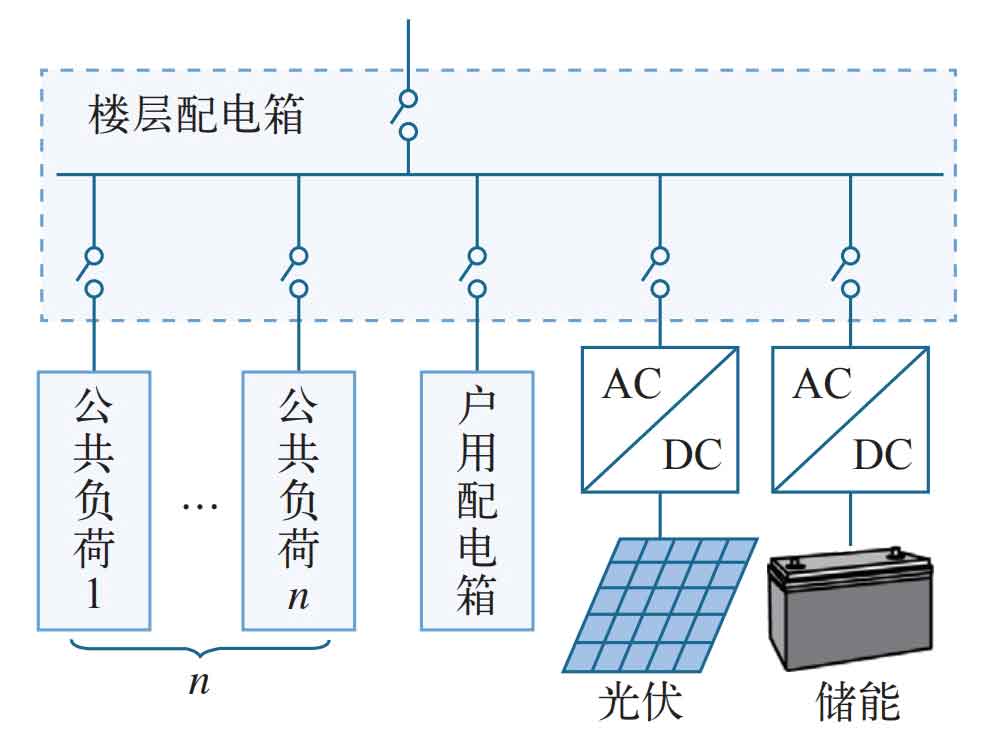
(2) The second commercial office type user side microgrid primary topology scheme
As shown in Figure 8, the distribution system of commercial office buildings is generally three-phase, and the distribution load of each floor includes three-phase and single-phase. The distribution system of each floor (including single-phase and three-phase) is designed by the owner, and the principle of relevant design is to “try to approach the total load of each phase as closely as possible”.
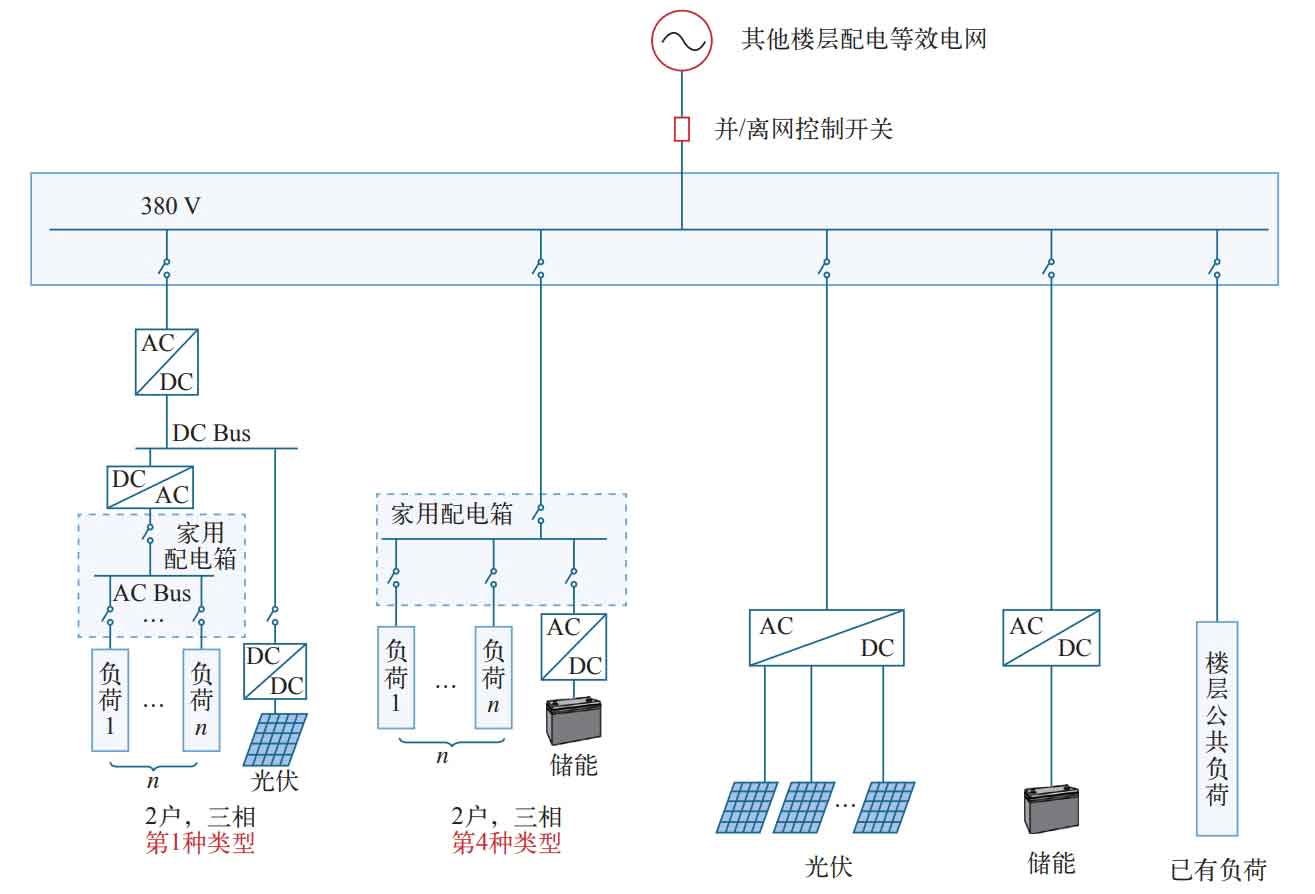
For this type of microgrid, it is possible to build a microgrid with different types of user topologies due to the different load assignments on each floor. This design has the following advantages: dispersed access to various new energy sources can provide users with more power supply circuits, promoting the large-scale popularization of new energy technology in various ways. Its disadvantages are that the control is relatively complex and the line renovation is more complex.
1) When the microgrid is integrated into the power grid for operation, the micropower supply can be controlled to meet the needs of each user’s load to the maximum extent possible. When the load is high and the power of the micro power supply cannot meet the requirements, electricity can be obtained from the grid or shared photovoltaic and energy storage systems on floors; When the load is low, control the photovoltaic and energy storage systems of each user to not send electricity back to the grid.
2) When the microgrid operates in isolation, users equipped with batteries can use their own batteries as the main power source to detect the power of the load, control the energy storage system, and ensure that the system can stably supply power to the load; Users who are not equipped with batteries can use a shared energy storage system for power supply.
4. Conclusion
With the continuous improvement and engineering practice verification of user side photovoltaic microgrid technology, it will further promote the development of the photovoltaic power generation industry. Therefore, it is necessary to actively carry out research on issues and technologies related to user side photovoltaic microgrids. Combining the characteristics of commercial user side microgrids and distributed power supply access methods, designing and analyzing typical topologies of commercial residential and office user side microgrids is the basis for studying user side microgrid control and protection technology, and is also one of the necessary conditions to ensure the safe and reliable use of electricity in user side microgrids.
